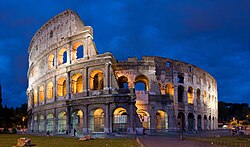Colosseum
Colosseum is situated just east of the Roman Forum. Construction began under the emperor Vespasian in AD 72, and was completed in AD 80 under his successor and heir Titus.[3]Further modifications were made during the reign of Domitian (81–96). These three emperors are known as the Flavian dynasty, and the amphitheatre was named in Latinfor its association with their family name (Flavius).
The Colosseum could hold, it is estimated, between 50,000 and 80,000 spectators, having an average audience of some 65,000; it was used for gladiatorial contests and public spectacles such as mock sea battles (for only a short time as the hypogeumwas soon filled in with mechanisms to support the other activities), animal hunts, executions, re-enactments of famous battles, and dramas based on Classical mythology. The building ceased to be used for entertainment in the early medievalera. It was later reused for such purposes as housing, workshops, quarters for a religious order, a fortress, a quarry, and a Christian shrine.
Although partially ruined because of damage caused by earthquakes and stone-robbers, the Colosseum is still an iconic symbol of Imperial Rome and is listed as one of the New7Wonders of the World. It is one of Rome's most popular tourist attractions and also has links to the Roman Catholic Church, as each Good Fridaythe Pope leads a torchlit "Way of the Cross" procession that starts in the area around the Colosseum.
| Location | Regio IV Templum Pacis ("Temple of Peace") |
|---|---|
| Built in | 70–80 AD |
| Built by/for | Vespasian, Titus |
| Type of structure | Amphitheatre |
| Related | List of ancient monuments in Rome |


No comments:
Post a Comment
Note: only a member of this blog may post a comment.